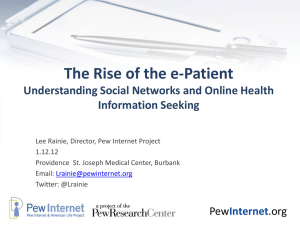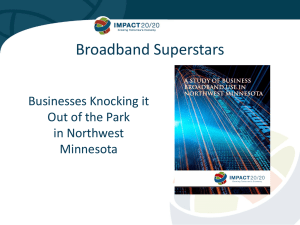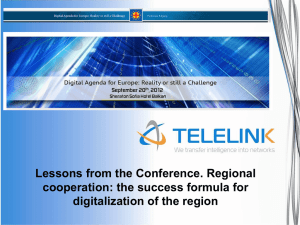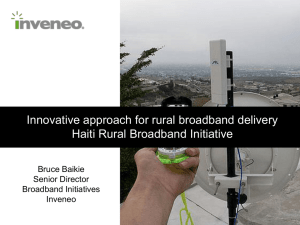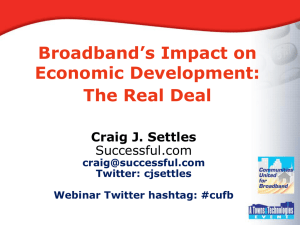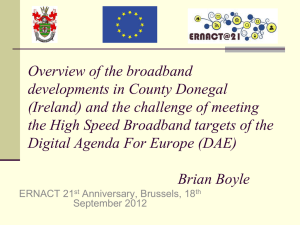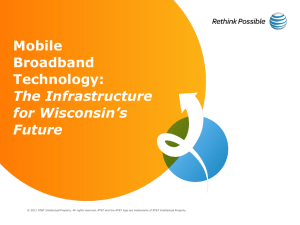The Social Media “Revolution” - Pew Internet & American Life Project
advertisement
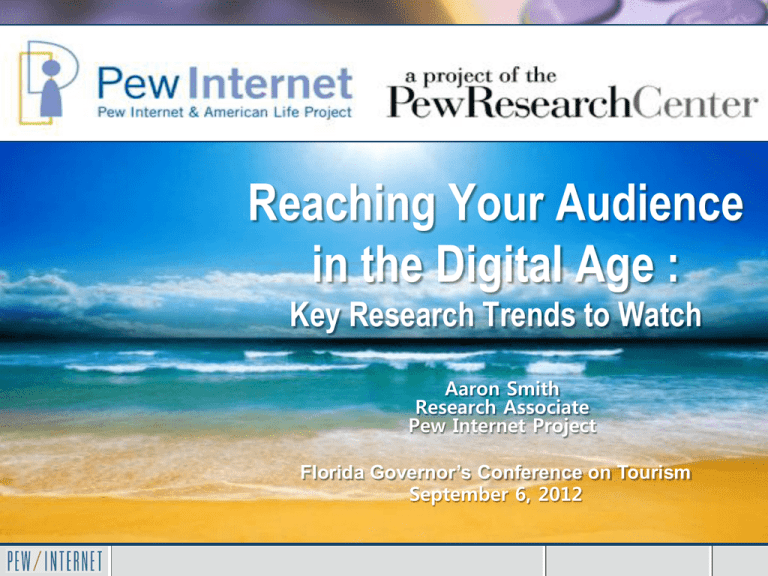
Reaching Your Audience in the Digital Age : Key Research Trends to Watch Aaron Smith Research Associate Pew Internet Project Florida Governor’s Conference on Tourism September 6, 2012 • Part of the Pew Research Center, a nonpartisan “fact tank” based in Washington, DC • PRC’s mission is to provide high quality, objective data to thought leaders and policymakers • Data for this talk is from nationally representative telephone surveys of U.S. adults (on landlines and cell phones, incl. Spanish) • Presentation slides and all data are available at pewinternet.org Tourism & the 3 Technology “Revolutions” Computers, internet and broadband Smartphones and mobile computing Social Media * The Internet/Broadband Revolution 85% of American adults (and 95% of teens) are now internet users Internet use by age group % of American adults age 18+ who use the internet (any device/location) 100% 97% = 94% for all 18-49 91% 90% 80% 70% 78% 77% 74% 60% 50% 53% = 2.6x increase 54% 40% 30% 20% 20% 10% 0% 2000 2001 2002 2003 18-29 2004 2005 30-49 2006 2007 50-64 2008 2009 65+ 2010 2011 2012 66% of Americans are home broadband users % of American adults age 18+ who have a high-speed broadband connection at home 80% 63% 70% 42% 33% 60% 16% 50% 40% 6% 62% 66% 47% 24% 11% 3% 41% 30% 66% 55% 34% 38% 37% 30% 28% 23% 20% 15% 10% 0% June 2000 10% April 2001 March 2002 March 2003 April 2004 March 2005 Dial-up March 2006 March 2007 Broadband April 2008 7% 5% 3% 3% April 2009 May 2010 Aug 2011 April 2012 Of course, not everyone has joined the internet/broadband revolution Roughly 1 in 6 adults do not use the internet, and 1 in 3 adults are not part of the broadband revolution Internet and broadband adoption are highest among: The financially secure and (especially) financially well-off Those under the age of 65 The well-educated (some college, college grads) Parents w/ children living at home Whites and English-proficient Asian Americans and Latinos Urban and suburban residents “The Broadband Difference” • Greater overall engagement in online activities • Search becomes the norm (92% of online adults) • Multimedia meets the masses: Watch online video (71%) Post photos online (46%) • Content creation and e-commerce take off: Buy a product (71%) Share something you created online (30%) Blogging (14%) Widespread access totally changes how we learn about businesses (even ones in our backyard) The sources people rely on the most for information about local businesses: Of those who cite the internet as a major source of info… 51% The internet • About 2/3 say they turn to search engines • About 1/3 turn to other online sources (such as topical or specialty sites) • This group skews towards 1839 year olds, college grads, mobile news consumers, recent transplants & parents 47% 31% Newspapers 30% 23% Word of mouth 22% 8% Local TV or radio 13% 0% 10% 20% Restaurants, bars and clubs 30% 40% 50% Other local businesses 60% Print sources are particularly relevant to older adults (esp. those 65 and older) Other key trends 8 in 10 adult internet users go online to research a product or service they’re thinking of buying 2/3 make air/hotel/car reservations online (2x increase vs. March 2000) Half have taken a virtual tour of a location online 1/3 have rated/reviewed a product, service or person online One downside to the internet/broadband revolution: information overload 7/10 adults are “overwhelmed by the amount of news and information available today”, and 1 in 5 are overwhelmed by the number of products (and info about those products) available to buy (still, ¾ like having lots of choices) Solutions to info overload: customization/personalization, reliance on friends and social networks, direct access to relevant info (apps, etc) Summary: Impact of Internet/Broadband Revolution Most (not all) are along for the ride Internet and broadband use widespread Usage especially high among a few key grps “E-travel” commonplace Vast majority of travelers now conducting pre-trip research and booking travel online Info seeking Heavy reliance on search as a starting point Challenges with info overload The Mobile Computing Revolution Comparing the Broadband and Mobile Revolutions Internet/Broadband Era Mobile/Social Era Stationary (desktop computer) Portable (laptop, tablet or smartphone) Flow of information Mainly one way Built for sharing, reviewing, & participating Info Consumption Discrete, task-oriented activity Continuous, alwayson activity Connection type Device ownership tells the story of the mobile revolution % of American adults age 18+ who own each device 100% 88% Now more laptops than desktops 80% 73% 61% 68% 60% 58% 46% 40% Now more smartphones than “regular” cell phones 35% 30% 20% 18% 2% 0% April 2006 Dec 2007 Cell phone (general) April 2008 Desktop April 2009 Laptop Tablet ownership up 6x in just two years 3% May 2010 May 2011 Smartphone E-reader April 2012 Tablet Around 1/3 of the country has given up their landline phones entirely (this is a huge deal for my line of work) Cell owners are doing more and more with their phones… % of adult cell owners who use their phones to… 100% 82% 80% 79% 73% 73% 65% 60% 53% 44% 44% 44% 38% 40% 29% 43% 34% 31% 27% 22% 20% 0% Take pictures Send/receive text msgs Access the internet Sept 2009 Send/receive email May 2011 Record video March 2012 Download apps …as smartphones become more and more widespread • 17% of all cell owners go online mostly using their cell phone, instead of a desktop or laptop computer • For many in the under-30 crowd, smartphones are an essential purchase—regardless of income level • Mobile devices alter the racial/ethnic “digital divide” story • Mobile users do more online, spend more time with content, share more with others Smartphone owners use their phones for a range of (complex/sensitive/advanced) activities % of smartphone owners who use their phones to… Check weather reports or forecasts 52% Use a social networking site 50% Get turn by turn navigation or directions while driving 77% 68% 15% 65% Play games 37% 64% Get news online 36% 64% Upload photos online 15% Listen to an online radio or music service 22% Check bank balance or do online banking 21% Look for health or medical info 6% Visit a government website 6% Use Twitter 10% Watch movies or TV shows through a paid… 4% 0% % do this on "typical day" 58% 53% 44% 43% 31% 16% 15% 20% 40% % ever do this 60% 80% 100% Apps can provide direct pathways to discovery and exploration of physical spaces Apps provide direct connections to information % of app downloaders who have downloaded each type of app… App use is particularly prominent among 18-29 year olds (65% of cell owners) Most app users turn regularly to just a small handful of apps… …but tourism-related activities (trip planning, exploration of physical location, reservations, reviews) are well suited to the apps world Tourism-specific examples of mobile devices and exploration of physical space/location % of all adults who have used a handheld device (phone/e-reader/tablet) to… View or download visual arts content 16% Watch or download a music, dance or theater performance 15% View or download info/images from a historic site, park or monument 12% Download or listen to audio tour at a museum, gallery or historical site View/download info or images from a museum 8% 6% 74% of smartphone owners use their phone to get directions, recommendations or other info based on their present location, and 21% use their phone to get coupons or deals to use at local businesses Key words of the ubiquitous mobility era: just-intime and spontaneous • 41% of cell owners have used their phone recently to coordinate a gathering or gettogether • 30% have used their phone recently to decide whether or not to visit a particular business, such as a restaurant • 20% have recently used their phone to visit a website that was mentioned on television (overall, half are “connected viewers”) Age comparisons: just-in-time info % of cell owners in each age group who have performed these real-time activities in the previous 30 days 60% 45 Coordinate a gathering 27 23 39 Solve an unexpected problem 49% 26 15 Decide whether or not to visit a business, such as restaurant Look up something to settle an argument 37 43% 18 18-29 12 45% 31 30-49 15 4 29 Look up sports score 33% 50-64 14 5 Get up-to-the minute traffic or public transit info 31% 23 65+ 11 4 21% Get help in an emergency situation 21 18 16 0% 20% 40% 60% Source: Pew Research Center’s Internet & American Life Mobile Survey, March 15-April 3, 2012. 80% 100% Summary: Impact of Mobile Revolution Just in time information Where can I get a deal? What’s something fun to do here? “Networked Info” packed into the physical travel experience Apps, QR codes, real-time deals Announcement and validation Sharing travel successes (or failures) in real time “Check out this awesome place I found!” The Social Media “Revolution” 2/3 of online adults use social networking sites, and nearly half do so on a typical day % of adult internet users who use social networking sites like Facebook, LinkedIn or Google+ 80% 61% 65% 66% 60% 46% 48% 43% 40% 38% 29% 27% 16% 20% 13% 8% 0% 9% 2% 2005 2006 2008 Ever 2009 2010 Typical day 2011 2012 Only search and email are more popular than social networking on a “typical day” basis % of adult internet users who do the following on a typical day Use a search engine to find information 59% Send or read e-mail 59 Use an online social networking site 48 Get news 45 Go online just for fun or to pass the time 44 Look for info on a hobby or interest 35 Check the weather 34 Look online for news or information about politics 28 Look for information online about a service or product you are thinking of buying 28 Watch a video on a video-sharing site like YouTube or Vimeo 28 Young adults lead the way on social network use, but older users are gaining ground Since 2009, use by 50-64 year olds has doubled; use by those 65+ has grown threefold (13% to 38%); women bigger users than men % of internet users in each age group who use SNS 100 80 92% 80% 73% 57% 60 38% 40 20 0 Teens 12- Adults 18-29 17 Teen Data July 2011 Adults 30-49 Adults 50-64 Adults 65+ Adult Data August 2012 Twitter is not as popular as other sites, but is growing steadily % internet users in each group who use Twitter… 16% of online adults now use Twitter, up from 8% in late 2010 Teen Data July 2011 Adult Data August 2012 Main Reasons American Adults Use SNS Stay in touch with current friends (67%) Stay in touch with family (64%) Reconnect with old friends (50%) Connect with people with shared interests or hobbies (14%) Make new friends (9%) Follow celebrities, athletes or politicians (5%) Find romantic partners (3%) Social networks give rise to “News Participators” As of Jan 2010, 37% of internet users contributed to, commented on, or disseminated news content via SNS 71% got news/info through email or SNS posts As of Jan 2011, 41% of adults were “local news participators” Share links to local news stories/videos Comment on local news stories/blogs Post info about their community on SNS Contribute to online discussions about their community Tag or categories local content Social networks allow for personal connections with public figures and entities… % of SNS/Twitter users who follow… Individual artists, musicians or other performers 41% Musical, dance or theater groups/venues Arts galleries or other visual arts orgs Museums 29% 11% 8% …and those personal connections can help you find and engage with your “Superfans” 44% of all adults have attended a live music, dance or theater performance in the last 12 months; it’s 77% for people who follow a music/dance/theatrical group or venue on a social networking site 35% of all adults have visited a museum in the last 12 months; it’s 82% for people who follow a museum on a social networking site 35% of all adults have attended an arts, craft or music festival in the last 12 months; it’s 55% for people who follow individual artists, musicians or performers on a social networking site 29% of all adults have visited an art gallery, show or exhibit in the last 12 months; it’s 82% for people who follow an art gallery or other visual organization on a social networking site Summary: Impact of Social Media Revolution For users/consumers Cutting through the clutter by getting advice from “people like me” (note: just one element of many in decision process) Helping others with recommendations Announcement/validation, part II For vendors/producers Forge direct connections with current & potential fans Variety and scale is a huge challenge— choose where to actively engage, where to lurk, where to ignore Current Impacts and Future Trends The New Reality: consumer expectations for information Information is free Information is “at my fingertips” Information is available whenever and wherever I want or need it Information is available from multiple sources Information is all around me Information is Woven Into Our Lives Mobile is the needle, Social Networks are the thread Mobile… Social Networks… Moves information with us Surround us with information through our many connections Makes information accessible ANYTIME and ANYWHERE Puts information at our fingertips Magnifies the demand for timely information Makes information location-sensitive Bring us information from multiple, varied sources Provide instant feedback, meaning and context Allow us to shape and create information ourselves and amplify others’ messages Next Generation “Info Weaving”: Augmented Reality What does all of this mean for YOU? You can be a… People today have access to more info than at any time in history. What they need is… Filter Curator Node in a Network Community Builder Lifesaver Tour Guide Trusted experts and filters to help them find, identify and utilize the best and most accurate information Someone to show them how/why information relates to them and is relevant to them Information purveyors can… Let people customize info to meet their own needs Provide people with direct access to the information that is most important to them Be a one-stop shop by aggregating info, providing links to related material, and recommending other sources Participate in online social networks and make information easy to share Information Purveyors Can… Create networks/communities around their info Facilitate connections between people with shared interests Get, listen to, and respond to feedback Identify and meet needs by tuning in to the online conversation Provide timely information when and where people need it most Make their information portable Operate in a 24/7 world, be constantly connected Connect their information to real-world places Create opportunities for information immersion and augmented realities THANK YOU!! All data available at: pewinternet.org Aaron Smith Research Associate Pew Research Center’s Internet & American Life Project asmith@pewinternet.org Twitter: @pewinternet
